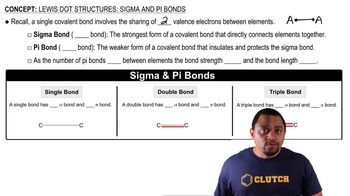Here are the essential concepts you must grasp in order to answer the question correctly.
Hybridization
Hybridization is the process by which atomic orbitals mix to form new hybrid orbitals that are suitable for the pairing of electrons to form chemical bonds. In the case of carbon in phosgene (Cl2CO), the carbon atom undergoes sp2 hybridization, resulting in three equivalent sp2 hybrid orbitals that are arranged in a trigonal planar geometry.
Recommended video:
Molecular Geometry
Molecular geometry refers to the three-dimensional arrangement of atoms within a molecule. For phosgene, the sp2 hybridization of carbon leads to a trigonal planar shape around the carbon atom, with bond angles of approximately 120 degrees. This geometry is crucial for understanding the molecule's reactivity and interactions with other substances.
Recommended video:
Molecular Geometry with Two Electron Groups
Pi Bonds
Pi bonds are a type of covalent bond that occurs when two lobes of one involved atomic orbital overlap with two lobes of another, typically involving unhybridized p orbitals. In phosgene, the carbon atom forms a double bond with oxygen through one sp2 hybrid orbital and one unhybridized p orbital, creating a pi bond that contributes to the molecule's stability and reactivity.
Recommended video:
Lewis Dot Structures: Sigma & Pi Bonds
 McMurry 8th Edition
McMurry 8th Edition Ch.8 - Covalent Compounds: Bonding Theories and Molecular Structure
Ch.8 - Covalent Compounds: Bonding Theories and Molecular Structure Problem 66
Problem 66 Verified step by step guidance
Verified step by step guidance


